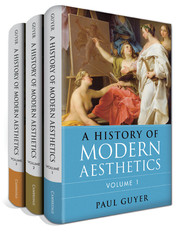Book contents
- Volume 1 The Eighteenth Century
- Frontmatter
- Epigraph
- Contents
- Acknowledgments
- Introduction
- 1 Prologue
- Part One Aesthetics in Britain, 1725–1800
- 2 From Hutcheson to Hume
- 3 Hogarth, Burke, and Gerard
- 4 From Kames to Alison and Stewart
- Part Two French Aesthetics in Mid-Century
- Part Three German Aesthetics between Wolff and Kant
- Part Four Kant and After
- Bibliography
- Index
- Volume 2 The Nineteenth Century
- Volume 3 The Twentieth Century
- References
4 - From Kames to Alison and Stewart
The Final Flowering
from Part One - Aesthetics in Britain, 1725–1800
Published online by Cambridge University Press: 05 June 2015
- Volume 1 The Eighteenth Century
- Frontmatter
- Epigraph
- Contents
- Acknowledgments
- Introduction
- 1 Prologue
- Part One Aesthetics in Britain, 1725–1800
- 2 From Hutcheson to Hume
- 3 Hogarth, Burke, and Gerard
- 4 From Kames to Alison and Stewart
- Part Two French Aesthetics in Mid-Century
- Part Three German Aesthetics between Wolff and Kant
- Part Four Kant and After
- Bibliography
- Index
- Volume 2 The Nineteenth Century
- Volume 3 The Twentieth Century
- References
Summary
After the 1750s, British aesthetics was almost exclusively a Scottish affair. But the Irishman Burke may nevertheless have had considerable influence in persuading some of the Scots to take a less exclusively moralistic view of the emotions raised by works of art than their own countryman Gerard had maintained. At least the Elements of Criticism of Henry Home, Lord Kames, although clearly influenced by Gerard’s pluralistic approach to the sources of pleasure in objects of taste, did not emphasize the moral sentiments produced by art as exclusively as Gerard did, nor did the leading “associationist” of the next generation, namely, Archibald Alison. But both of these thinkers had in common with the writers of the 1750s that they did not conceive of works of art primarily as vehicles for the cognition of important ideas and truths, moral or otherwise, but rather emphasized the free engagement of our mental powers, both cognitive and moral, in aesthetic experience. Toward the end of the period to be considered in this chapter, however, the cognitivist approach to aesthetics, what we might consider within the British context the Shaftesburian rather than Hutchesonian approach, enjoyed a revival in the work of Thomas Reid and his chief disciple, Dugald Stewart. In between Kames and Reid, variants of both the aesthetics of play and the aesthetics of truth were developed by Adam Smith, James Beattie, and the English painter Joshua Reynolds. In this chapter we shall thus see that in the final phase of eighteenth-century British aesthetics a complex tapestry was woven with all three of the main threads of eighteenth-century aesthetic theory, although in no case are all three threads woven together by a single author.
- Type
- Chapter
- Information
- A History of Modern Aesthetics , pp. 176 - 244Publisher: Cambridge University PressPrint publication year: 2014



